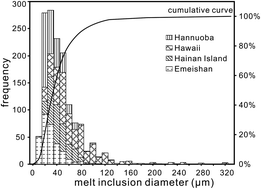Lead isotope analysis of melt inclusions by LA-MC-ICP-MS†
Abstract
Pb isotope compositions of melt inclusions provide unique information about the composition of primary magmas and their source. In this study, we have developed a method for measuring Pb isotopes in small olivine-hosted melt inclusions (>40 μm) from young and old volcanoes by LA-MC-ICP-MS. We used a new interface cone assemblage consisting of a Jet sample cone and X skimmer cone. A small flow of N2 gas was added to the carrier gas and passed through the assemblage to enhance the signal intensity. In addition the energy and repetition rate of the laser conditions were reduced and the signal integration time was shortened in order to lengthen the laser ablation time and to collect enough data. Mass bias and instrument drift were corrected using a standard–sample–standard bracketing method. The analysis routine employed eight ion counters to receive 238U, 235U, 232Th, 208Pb, 207Pb, 206Pb, 204Pb and 202Hg signals simultaneously, which allowed Hg interference to be corrected on 204Pb, and in old samples U–Th decay to be age-corrected. Using the Jet and X cones, under the same laser ablation conditions, the precisions for almost all the measured standard glasses are improved by at least a factor of two compared to using standard cones. At 208Pb signal intensity >200 000 cps, external precisions of ratios involving 204Pb are better than 1.3% (2RSD) and precisions of 208Pb/206Pb and 207Pb/206Pb are better than 0.23% (2RSD). The results of Pb isotopes in olivine-hosted melt inclusions, using 45 μm laser spots, show that the internal precisions of 208Pb/206Pb and 207Pb/206Pb for most analyzed melt inclusions are better than 0.2% (2RSE) and for ratios involving 204Pb are better than 0.8% (2RSE). We are able to present the first ever Pb isotope data from ∼260 Ma Emeishan flood basalt olivine-hosted melt inclusions. They show the importance to do age correction which results in the reduction of the spread of data in old samples. The mean values of age-corrected 208Pb/206Pb and 207Pb/206Pb have 1.2% and 2.8% deviations from the uncorrected mean values, respectively. The method developed here provides a fast, precise and accurate in situ Pb isotopic composition analysis, applicable not only to melt inclusions from young basalts, but also from old samples that require correction for U–Th decay.


 Please wait while we load your content...
Please wait while we load your content...